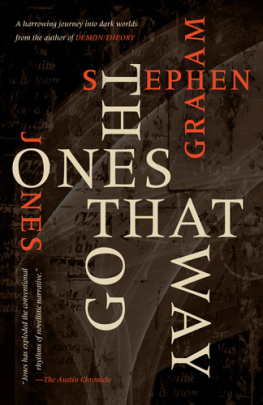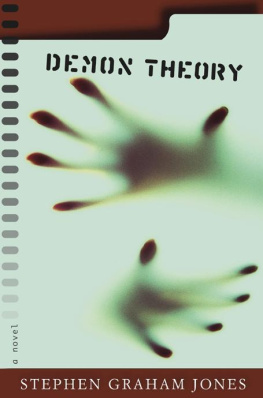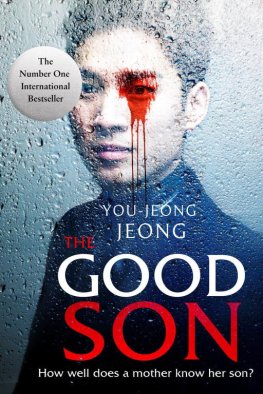THE ONES THAT GOT AWAY
STEPHEN GRAHAM JONES
for Sulac and Detective Bruiseman

Copyright 2010 by Stephen Graham Jones.
Cover design by Stephen H. Segal.
Ebook design by Neil Clarke.
Introduction copyright 2010 by Laird Barron.
ISBN: 978-1-60701-321-1 (ebook)
ISBN: 978-1-60701-235-1 (hardcover)
Prime Books
www.prime-books.com
No portion of this book may be reproduced by any means, mechanical, electronic, or otherwise, without first obtaining the permission of the copyright holder.
For more information, contact Prime Books.
Man has gone out to explore other worlds and other
civilizations without having explored his own labyrinth
of dark passages and secret chambers, and without finding
what lies behind doorways that he himself has sealed.
Stanislaw Lem
Its close to midnight and something evils lurking in the dark
Michael Jackson
Table of Contents
, Laird Barron
Introduction: No Escape
by Laird Barron
A finger bone vomited into park grass. A snake oil salesman traveling through the land of the dead. A primeval island where the human population of one is about to tick over to zero. A baby monitor that transmits on a damned frequency. Cannibalism. Black magic. Murder. Mans best friend, until the end. First love. True love. Childhood. Machetes. The Dark.
Brace yourself.
The Ones That Got Away is a slippery collection; it resists and gnaws at the bonds of genre, yet may be the most pure horror book Ive come across. The cumulative effect of these stories induces dislocation and dreadthe manner of dread that arises from what is known by our soft, weak, civilized selves through rote and sedentary custom and symbolic exchange of cautionary fables, as well as a deeper, abiding fear of the ineffable thats the province of the primordial swamp of our subconscious. The Ones That Got Away acts as a literary taproot intercepting the delta waves of humanitys ancestral lizard slumbering in muck. The beast dreaming a future where it has shed scale, fang, and claw, and goes forth on two puny legs, an organism evolved and refined, albeit eternally fettered to its savage provenance via genetic memory and vestigial apparatuses.
Homo sapiens havent come very far, not really. We are quick to anger, quick to draw blood; quick to breed, quicker to flee. From the slopes of our brows to the shelves of our breastbones humans are designed to withstand death from above. While our savage instincts have atrophied, the beast merely sleeps, its lusts and rages merely sublimated, its fears merely quieted. Our collective blissful ignorance of the awesome nature of the universe and our amoebic place therein, as Lovecraft opined, shields us from gibbering madness while leaving intact the basic intellectual curiosity that defines us, elevates us from the beasts. Driven by curiosity and greed, but protected in equal measure by cowardice and short memories, what a contradiction is man.
Stephen Graham Jones is tuned into the phenomena of this dualitythe fault line running through rationality, the divide between animal and man, and what we know and the actual truth. With this book hes acquired a distress signal emanating from the prehistoric brain and committed it to paper, produced an artifact that satisfies the requirements of literature as entertainment while translating on the subliminal register. It is a crystal clear message: all is not well, nothing has ever been, nor will ever be, and that we begin this life covered in blood, screaming. Ultimately, we dont, cant, escape the circumstances of our origins.
Childhood lost. Youth corrupted is the touchstone, the recurring theme in The Ones That Got Away . Everything, everything, begins and ends with childhood, for as children Joness protagonists dwell closest to the animal state that powers the overmind, are thus privy to, albeit powerless against, the terrible truth, have not developed a thick, insulating shell of incredulity, and are thus scarred, if not damned to be receivers and carriers of horror. Children, with their partially-formed consciousness and absent morality, their natural affinity for the inexplicable, their essential vulnerability, get it, the essence of horror, you see. The wounded ones get it double.
Joness adult characters who remain forever those damaged children on the inside, yet devastatingly estranged from any shred of youthful innocence, get it too. These mature protagonists bear the formative wounds and are especially sensitive to the darkness that seeps between cracks, alive as a raw nerve to the intrusion of the supernatural. Cursed with perspective, that bitter fruit of age and wisdom, such men and women cannot help but apprehend the existence of something larger than themselves, its encroachment, how it stains and deforms the fabric of reality, stains and deforms their own flesh and spirit. They are forced to come to grips with the hideous realization that the inequities of childhood, its attendant suffering and imbalances of power, are relative, a socio-economic parallax that persists from birth to death. Good and evil are empty words against the inchoate energies that twist the material world, tears it to ribbons without notice. Like the song says, there aint no good guys, there aint no bad guys, theres only you and me. Perhaps the darkest hour anyone will endure is that which succeeds the epiphany that the sublime and monstrous are equally inheritable traits. Behind the faces of good and evil, ruination and corruption, lies an insensate, inchoate vista of blind stars sprinkled across the maw of vast, lightless space.
The pieces herein radiate the dark energy of fairy tales. The good kind, the kind with sex and cannibalism, occultism and murder, awe and wonder. Horror. That Jones appropriates this ancient mode, deconstructs and flenses it with his high-pressure stream of consciousness narratives, is grimly appropriate. In his hands, the fairy tale isnt simply a trifle or diversion, nor at heart the sanitized parable so popular in public education, but a fragment of cosmic code, a warning and a promise, the mesmerists chime that snaps a mind from one plane to another. Fairy tales, the down and dirty ones courtesy Black Forest campfires of ages past, are frightful correspondence with the dark, nightmare communications from the primal wellspring.
Indeed, the power of nightmares defines this collection. Joness stories are nightmarish for the clarity of their manifest terrors often hatched from scenarios weve envisioned in the wasteland hours between falling into bed and crawling from it. Joness stories are also nightmarish for their moral ambiguity and their juxtaposition of the seedy, grimy dirt-in-the mouth taste of reality with that of the supernatural, the diabolical and the numinous. Yet the experience of them rapidly escalates from reading accounts of discrete nightmares to actually participating in the grotesquerie, becoming entangled, infected, scarred. Hes fractured the big, black picture window that overlooks the benighted regions of the soul. Each story is a fragment of that glass, and some of the imagery is jagged as the hell it evokes.
You cant go home, can never go back where you started from, is what they say like its a tragedy, a curse. There are those who dont get to leave in the first place. The ones caught in the ankle-hold traps of poverty and abuse, corrupted by the dark days of bad childhoods, the ones who get lost in the haunted forests that surround suburb and city, backwoods shack and brownstone alike. All those kidsnow grown into men and womenwho dwell on the fringes of the mythical Great American dream carry on as shadows of themselves cast down through the long years. Predators and victims by turn. The ones who dream the ancient dream, who cant quite shake it upon waking and thus remain ensnared, body and soul. The ones who almost got away, but didnt.
Next page








